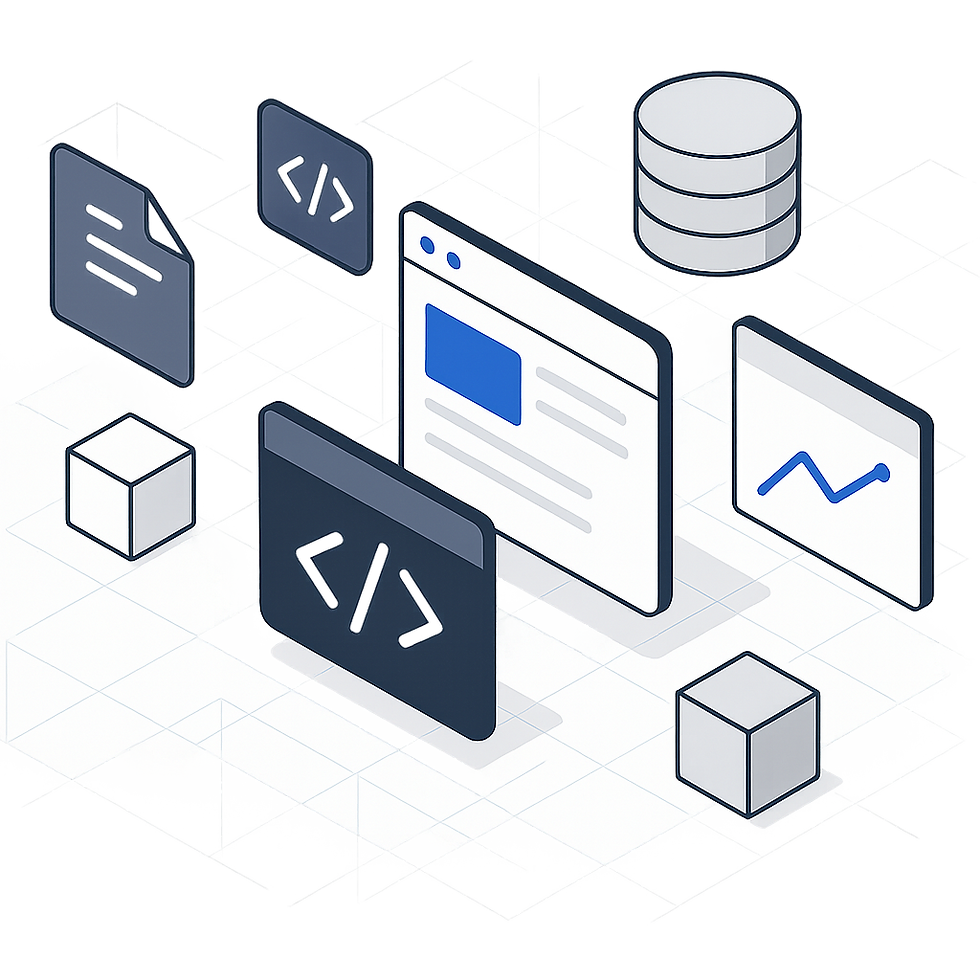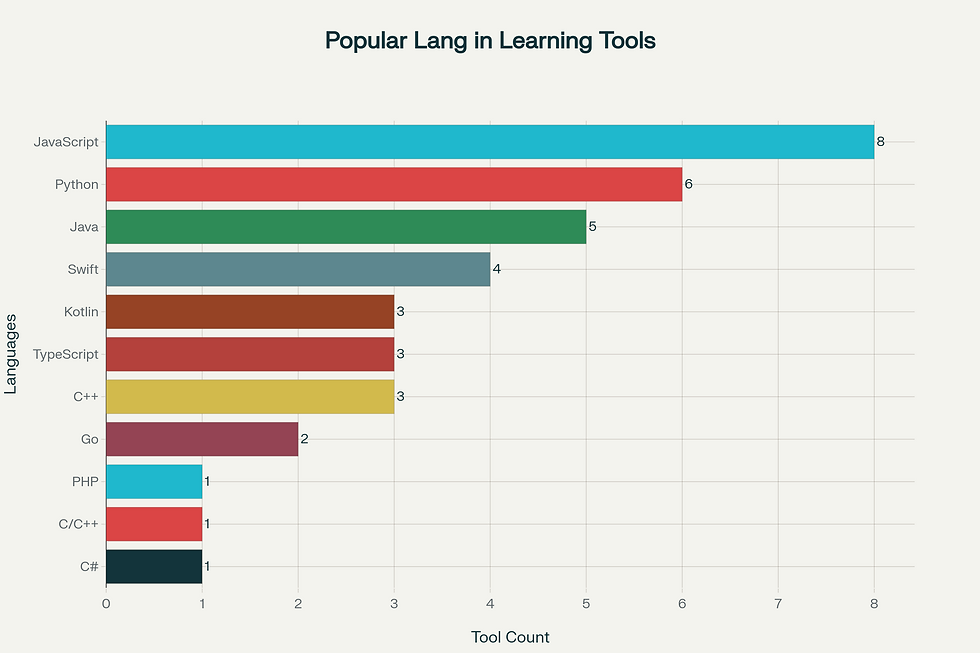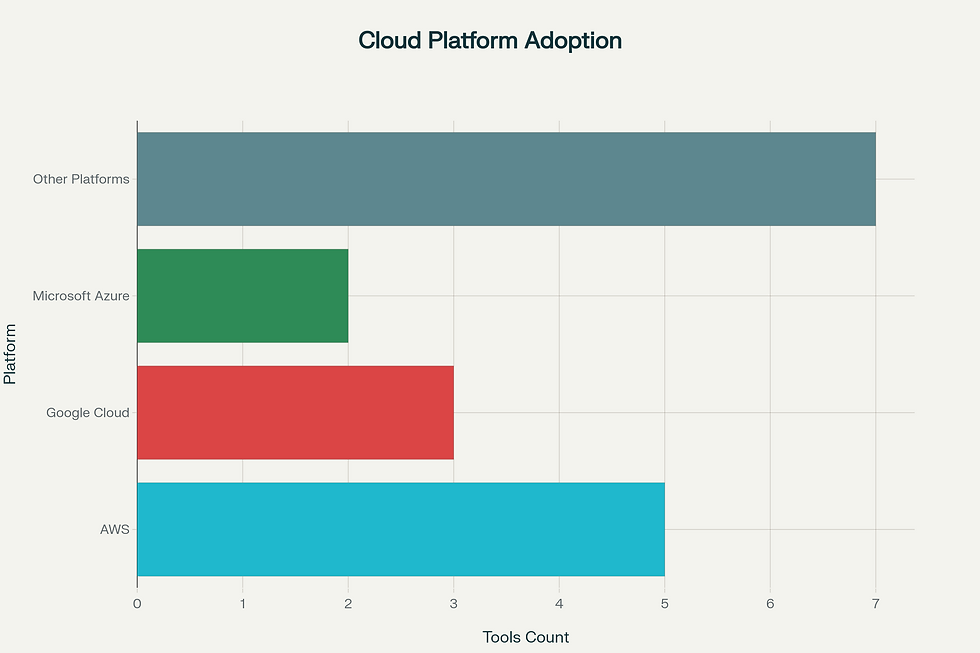Tech Stack DNA: Decoding the 2025 Blueprint of Top Learning Tools
- Krzysztof Kosman

- Sep 3
- 6 min read

Is Your Next Learning Tool Built to Last—or Just to Launch?
Every few weeks, another bold new EdTech platform makes headlines. Platforms promise artificial intelligence tutors, immersive video lessons, and “effortless” multi-device access. But by 2025, the most successful education tools share a powerful secret—one that’s not always obvious from the UI or the marketing. The difference is in their technology DNA. Today’s winning learning platforms are as much defined by what’s under the hood—the frameworks, programming languages, and infrastructure choices—as their user experience. For EdTech founders, product managers, and technology teams, understanding these patterns is the key to not just launching, but lasting.
Why This Matters Now: The Shift to Strategic, Not Just Speedy, Tech Decisions
In an era where "move fast and break things" feels increasingly risky for the education sector, the technology choices behind learning tools are more strategic than ever. The 2020s saw a scramble: institutions and startups rushed to get online, cobbling together apps in whatever stack offered the fewest hurdles. But the most successful platforms in 2025 have matured, showing clear patterns in both what they use—and what they leave behind.
As Krzysztof Kosman wrote in Tech Won’t Save Schools — Unless We Face the Real Crisis: “Each year, education conferences unveil the latest jaw-dropping gadget… but only those that offer invisible stability and universal accessibility take root.”
To dig into this, we analyzed the technology stack choices behind nine of the most impactful learning tools in 2025—including platforms such as ChatGPT, Duolingo, YouTube, TikTok, Canva, Moodle, and Google Classroom. We compared public data, technology audits, engineering interviews, and trends from similar EdTech innovators. Here’s what a deep dive into their technology DNA reveals for 2025—and what it means for every new EdTech startup.
The Most Popular Programming Languages for Top Learning Tools

1. JavaScript (and TypeScript) as the Universal Web-First Language
JavaScript powers 8 of 9 top learning platforms in our sample—an overwhelming signal that web-first, cross-platform design remains the priority into 2025. There’s a paradox at work here: although mobile usage keeps climbing, the winning learning tools don’t start mobile-only. They start accessible—immediately, on any device. The shift isn’t just about writing once, run anywhere (though that helps). It’s about lowering barriers to engagement, especially in classrooms and districts where not everyone downloads new apps. TypeScript, the safer, scalable version of JavaScript, is increasingly the default for mature teams (as seen in Canva’s migration from JavaScript to TypeScript with React).
Strategic takeaway: Young EdTech companies should default to JavaScript/TypeScript, leveraging frameworks that enable component-based reuse and speed—citing examples such as React’s dominance.
See also: OpenAI Codex + VS Code: The AI Coding Experience You Have to Feel to Believe (showing how cross-platform scripting accelerates EdTech lift-off).
2. Python: The AI and Backend Lingua Franca
Python is used by 6 of 9 top tools and is the default choice whenever learning platforms embrace AI—especially in platforms like ChatGPT, Duolingo, and YouTube’s backend. Its libraries for machine learning (TensorFlow, PyTorch, scikit-learn, etc.) are unrivaled, and the data engineering community has settled on Python as a universal glue. At massive scale, platforms like YouTube have demonstrated Python’s durability for backend logic, orchestration, and data pipelining.
Any EdTech platform seeking features such as personalized practice, automated grading, or adaptive content needs a serious Python competency for its core AI logic.
Differentiate with AI? Adopt Python—there's no serious competitor in EdTech machine learning by 2025.
3. Native Mobile? Swift and Kotlin as Standard — But Always in Tandem with Web
Swift (for iOS) and Kotlin (for Android) have become the industry standard for top mobile experiences. While React Native or Flutter are tempting for unified codebases, the very top apps—including TikTok—still use native mobile codebases for the best performance. The industry pattern, however, is not to supplant the web app with mobile, but to complement: the mobile version becomes a tailored, frictionless extension—not a replacement. Case in point: Duolingo’s learning algorithms and practice sessions run cross-platform because their API-first, backend-pipeline mindset allows the same personalization logic on both web and mobile.
4. Cloud Evolution: AWS Leads, but Multi-Cloud Grows
The majority of the top tools still lean on AWS, but multi-cloud and global performance strategies are gaining ground. When TikTok needs to serve millions of videos worldwide with low latency, for example, they combine AWS, Google Cloud, and edge caching. This isn’t just insurance against outages; it’s about pricing power, regional data privacy, and serving students wherever they are.
Strategic tip: The future of EdTech is cloud-native, but startups should architect for multi-cloud options as scale and compliance demands grow.
Want resilience in the face of AWS policy shifts or regional politics? Multi-cloud or cloud-agnostic design is now a practical priority.
5. Framework Maturity: React, Spring Boot, and the Microservices Advantage
React and Spring Boot together power 3 of the top tools each. What’s going on?—Both represent technology that’s stable, extremely well-supported, and makes it easier for growing teams to maintain large platforms. The industry migration from vanilla JavaScript or legacy PHP to type-safe, component-based (React/TypeScript) or modular backend architectures (Spring Boot in Java, Django in Python) is nearly complete. TikTok, Canva, and Duolingo follow this pattern: starting fast, then leaning into frameworks that support rapid iteration and world-class engineering practices.
Why not Flutter, Angular, or another hot framework? In high-stakes EdTech, stability and ecosystem trump experimentation.
What About EdTech-Specific Insights?
Language App Innovation: Duolingo, for example, exemplifies the cutting edge: a mix of React Native for cross-platform UI, TensorFlow/Python for AI, and PostgreSQL for fast, reliable data management. Personalized learning, by 2025, is always a function of Python’s AI/data pipelines working in tandem with robust APIs.
LMS Traditionalism: Moodle doubles down on proven technologies: PHP backend and JavaScript front end. Legacy systems in schools still crave stability and API compatibility over novelty, but the pattern is gradual modernizing (incrementally plugging in AI/analytics through Python or integrations).
Video and Interactive Content: YouTube’s multilayered approach—Python orchestrating, C++ and Go for high-performance streaming, Java for scale—sets the gold standard for those entering video-based learning tools.

Strategic Opportunities for EdTech Startups: Where Are the Gaps?
Edge Computing for Offline Learning: Cloud-first is dominant, but platforms serving rural or low-connectivity regions need to explore edge-compute for local, offline-first content delivery—a greenfield for mission-driven EdTechs.
WebAssembly for Performance: No leading tool has embraced WebAssembly in their user-facing stack—yet. High-performance simulations, advanced interactive labs, and secure sandboxing via WebAssembly could unlock new browser-based learning experiences.
Progressive Web Apps (PWA): With limited PWA adoption, there’s opportunity for app-like, offline-capable tools that bypass app store restrictions—vital for markets where phone storage or device diversity is an issue.
Blockchain for Credentials: The absence of blockchain in leading solutions creates space for startups to pioneer open, verifiable digital credentialing—particularly for micro-credentials, upskilling, or cross-border education validation.
So What Should Founders, Teams, and Educators Rethink?
The top learning platforms don’t chase the newest fad—they double down on technological patterns that emphasize scalability, accessibility, and resilience. If you’re launching or modernizing an EdTech tool in 2025:
Start with JavaScript/TypeScript + React for the frontend (and rapid prototyping), but plan for migration to type-safe, reusable architectures as you grow.
Use Python backends for anything AI-driven; invest in data science pipelines from day one.
Adopt API-first and microservices mindsets to enable true multi-platform reach and future modularity.
Choose cloud-native platforms but with an eye to multi-cloud and edge innovations as you scale or address global diversity.
And, as highlighted in Tech Won’t Save Schools, technology must remain a servant—not the story itself.
The classroom success depends not just on algorithms or APIs, but on creating platforms that educators and learners can rely on, plug into, and trust over time.
For further reading
Maturity, Not Hype, Wins in 2025 EdTech
The next great learning tool will not be the one with the newest mobile interface or the most buzzword-laden AI demo. It will be the one whose architecture reflects the tested technology patterns of the platforms before it—made both to adapt, and to endure. What “invisible” technology decision will determine whether your next learning platform endures?


